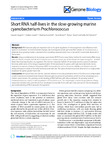Short RNA half-lives in the slow-growing marine cyanobacterium Prochlorococcus
| dc.contributor.author | Steglich, C | |
| dc.contributor.author | Lindell, D | |
| dc.contributor.author | Futschik, Matthias | |
| dc.contributor.author | Rector, T | |
| dc.contributor.author | Steen, R | |
| dc.contributor.author | Chisholm, SW | |
| dc.date.accessioned | 2017-02-07T19:32:46Z | |
| dc.date.available | 2017-02-07T19:32:46Z | |
| dc.date.issued | 2010 | |
| dc.identifier.issn | 1465-6906 | |
| dc.identifier.issn | 1474-760X | |
| dc.identifier.other | ARTN R54 | |
| dc.identifier.uri | http://hdl.handle.net/10026.1/8401 | |
| dc.description.abstract |
BACKGROUND: RNA turnover plays an important role in the gene regulation of microorganisms and influences their speed of acclimation to environmental changes. We investigated whole-genome RNA stability of Prochlorococcus, a relatively slow-growing marine cyanobacterium doubling approximately once a day, which is extremely abundant in the oceans. RESULTS: Using a combination of microarrays, quantitative RT-PCR and a new fitting method for determining RNA decay rates, we found a median half-life of 2.4 minutes and a median decay rate of 2.6 minutes for expressed genes - twofold faster than that reported for any organism. The shortest transcript half-life (33 seconds) was for a gene of unknown function, while some of the longest (approximately 18 minutes) were for genes with high transcript levels. Genes organized in operons displayed intriguing mRNA decay patterns, such as increased stability, and delayed onset of decay with greater distance from the transcriptional start site. The same phenomenon was observed on a single probe resolution for genes greater than 2 kb. CONCLUSIONS: We hypothesize that the fast turnover relative to the slow generation time in Prochlorococcus may enable a swift response to environmental changes through rapid recycling of nucleotides, which could be advantageous in nutrient poor oceans. Our growing understanding of RNA half-lives will help us interpret the growing bank of metatranscriptomic studies of wild populations of Prochlorococcus. The surprisingly complex decay patterns of large transcripts reported here, and the method developed to describe them, will open new avenues for the investigation and understanding of RNA decay for all organisms. | |
| dc.format.extent | R54-R54 | |
| dc.format.medium | Print-Electronic | |
| dc.language | en | |
| dc.language.iso | eng | |
| dc.publisher | Springer Science and Business Media LLC | |
| dc.subject | Adenosine Triphosphatases | |
| dc.subject | Cluster Analysis | |
| dc.subject | DNA-Directed RNA Polymerases | |
| dc.subject | Gene Expression Profiling | |
| dc.subject | Gene Expression Regulation, Bacterial | |
| dc.subject | Genome, Bacterial | |
| dc.subject | Half-Life | |
| dc.subject | Oligonucleotide Array Sequence Analysis | |
| dc.subject | Operon | |
| dc.subject | Prochlorococcus | |
| dc.subject | RNA Stability | |
| dc.subject | RNA, Bacterial | |
| dc.subject | RNA, Messenger | |
| dc.subject | Reverse Transcriptase Polymerase Chain Reaction | |
| dc.subject | Ribosomal Proteins | |
| dc.subject | Seawater | |
| dc.subject | Time Factors | |
| dc.subject | Transcription, Genetic | |
| dc.title | Short RNA half-lives in the slow-growing marine cyanobacterium Prochlorococcus | |
| dc.type | journal-article | |
| dc.type | Journal Article | |
| dc.type | Research Support, Non-U.S. Gov't | |
| dc.type | Research Support, U.S. Gov't, Non-P.H.S. | |
| plymouth.author-url | https://www.webofscience.com/api/gateway?GWVersion=2&SrcApp=PARTNER_APP&SrcAuth=LinksAMR&KeyUT=WOS:000279631000019&DestLinkType=FullRecord&DestApp=ALL_WOS&UsrCustomerID=11bb513d99f797142bcfeffcc58ea008 | |
| plymouth.issue | 5 | |
| plymouth.volume | 11 | |
| plymouth.publication-status | Published | |
| plymouth.journal | Genome Biology | |
| dc.identifier.doi | 10.1186/gb-2010-11-5-r54 | |
| plymouth.organisational-group | /Plymouth | |
| plymouth.organisational-group | /Plymouth/Faculty of Health | |
| plymouth.organisational-group | /Plymouth/Users by role | |
| dc.publisher.place | England | |
| dcterms.dateAccepted | 2010-05-19 | |
| dc.identifier.eissn | 1474-760X | |
| dc.rights.embargoperiod | Not known | |
| rioxxterms.versionofrecord | 10.1186/gb-2010-11-5-r54 | |
| rioxxterms.licenseref.uri | http://www.rioxx.net/licenses/all-rights-reserved | |
| rioxxterms.licenseref.startdate | 2010 | |
| rioxxterms.type | Journal Article/Review |


